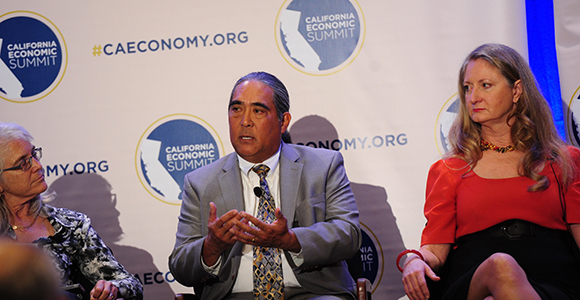
A.G. Kawamura, co-chair of Solutions From the Land and co-lead of the Summit’s Working Landscapes Action Team (middle) on a water panel at the 2015 California Economic Summit on Friday in Ontario, California, joining Celeste Cantú of the Santa Ana Watershed Project Authority (right), and Ashley Boren, executive director of Sustainable Conservation (Photo Credit: Violeta Vaquerio)
California has always had issues with water, but the last few years of drought has brought the issue to the forefront. At the 2015 California Economic Summit in Ontario this week, participants committed to promote policies that will save one million acre feet of water each year for the next ten years as part of the Summit’s “One Million Challenges.”
Co-presented by California Forward and the California Stewardship Network, the Summit brought together civic and business leaders from across the state to discuss how to move California along the path to prosperity.
“Even before the drought, Californians were using more water than we had,” Ashley Boren of Sustainable Conservation. She said California needs to work toward finding a way to conserve, capture and reuse water at the regional level so that the state can return to a better water balance.
Boren led a conversation with Celeste Cantú, manager at the Santa Ana Watershed Project Authority, Robin Gilthorpe of WaterSmart.com, A.G. Kawamura of Solutions from the Land and Jay Ziegler of The Nature Conservancy to discuss the state of water use in California.
Cantú stressed the need for better water management from the time it drops in the mountains, all the way down to the end of rivers. But, Cantú said the goal will take much more collaboration between communities, which will necessitate the need for skills that participants in this space sometimes lack. “There is a need for soft skills, conversations and negotiations because the biggest need is for information,” said Cantú.
“California is the fifth largest agriculture economy in the world,” said Kawamura, “We have to start thinking about the future. If we don’t act, then shame on us because we have plenty of examples. Kawarmura cited Israel and Aspen as areas that have more successfully dealt with water issues.
Ziegler said California need to coordinated approach that shakes everything up, asking “How do we get regionally more self-sufficient?”
Participants worked to answer that question and others during an interactive session where they engaged and committed to the priorities put forward to achieve the challenge. The 2016 priorities include:
- Identify regional outcomes for integrated water management, which includes measuring and reporting.
- Develop and advance integrated regional/watershed management solutions
Connect headwaters and users and urban and rural communities. Also support regional efforts and innovations to conserve, capture and reuse water.
- Address funding and financing constraints and incentives
Support integrated solutions including water pricing, Prop 128 revisions, public goods charges, ecosystem services and Enchanced Infrastructure Financing Districts
- Promote inter-agency coordination and alignment to remove barriers
Align state regulatory policy, integrate local authorities and educate the public
- Improve connections between land use planning and water management
Integrate water resource management into local and regional land-use plans
- Address the needs of disadvantaged communities
Include water quality, reliability and affordability
Summit participants will now return to their regions to work on implementing the priorities in order to achieve the One Million Challenge Goal.

